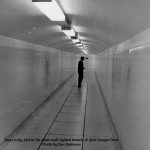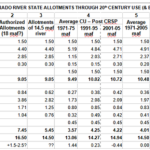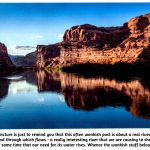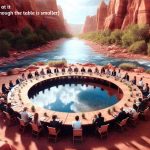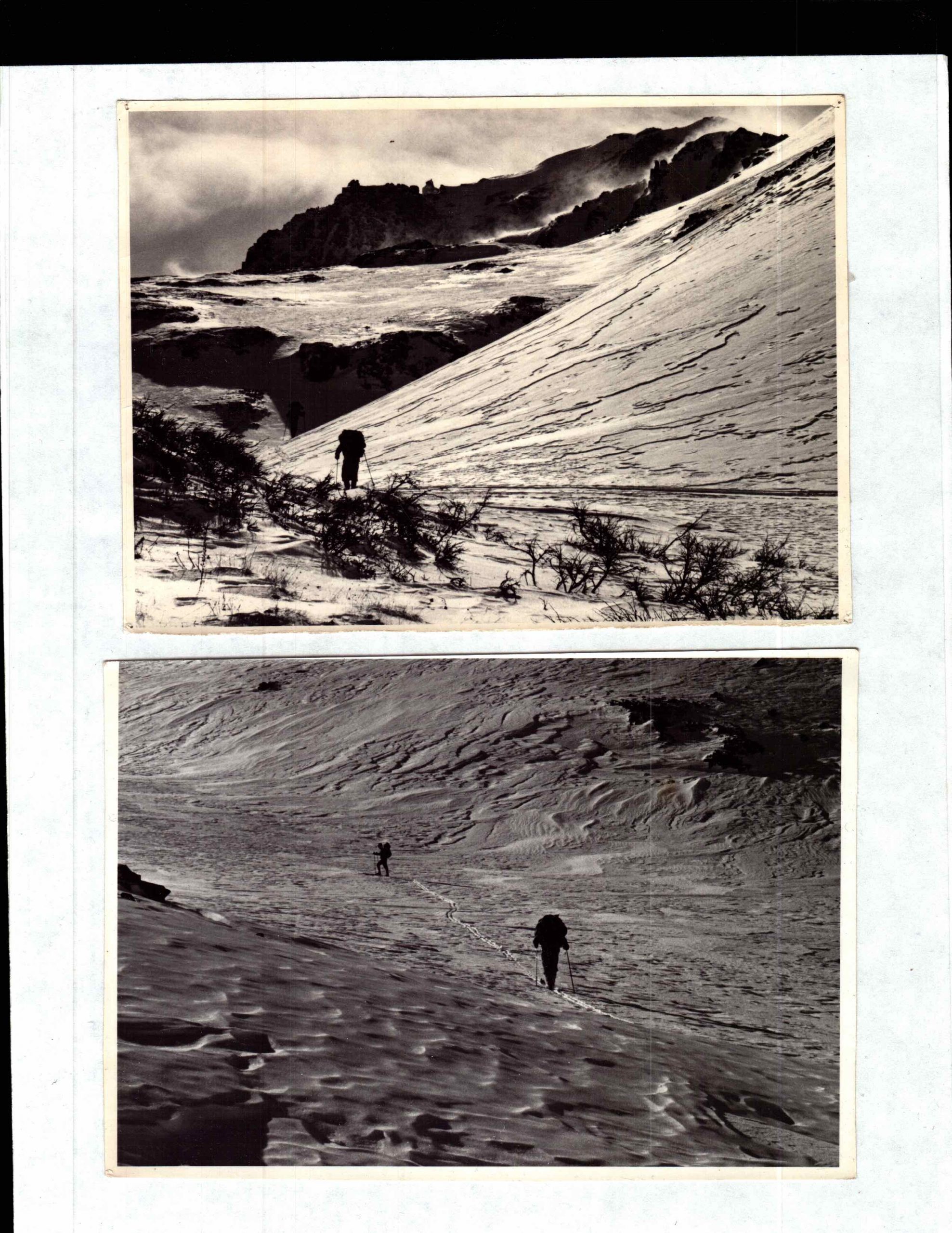
First published as part of the second edition of Dragons in Paradise, in 2014.
Friends to Cross Passes With
It was getting dark, and snowing harder, and I was wondering if they were actually crazy enough to have come out on this fool’s adventure. Was I going to get to the cabin and find out that they’d done what I’d seriously considered – looked at the thickening sky that afternoon, felt it get still and warmish the way it gets when it’s going to snow, and done the only intelligent thing and stayed home?
This was way before the cell phone era; I had no way of contacting them. Should I turn around, go back home while there was still a little light and what was left of my disappearing track to follow….
But I didn’t. I operated on past experience indicating that they were as stupid or crazy as I was, and so I plowed on across the divide between the East River and Washington Gulch to where I thought Frame’s cabin was – the historic old Elkton cabin that a skier eventually accidentally burned down.
And sure enough: right at dusk, I saw a light below and ahead, a lantern in a window; and there they were, just as I’d figured, out on a night when no one in their right mind would be out. And after a moment of hooting and moaning outside the window, playing the Elkton ghost so they’d be glad to find it was just me, I went into the warm, and they were no more surprised, nor less relieved, to see me than I was to see them, and Benjamin held out the schnapps and asked what kind of a fool I was, to be out skiing in the dark in a snowstorm.
*
This is an essay to explain the cover photo for the first edition of this book – with the story in this edition but a different cover photo. The picture is actually misleading for most of the content of this book: it suggests a book about rugged mountaineering, challenging nature, dangerous treks, and all of that, and I’m not really that kind of person at all. But one does find oneself in all kinds of strange situations if one lets oneself, and this story is about that.
A lot of places in the West, including most of our mountain towns, have been terminals as much as towns, especially for the people in the 20-to-30 age range that populate the West of the imagination. Etymologically, “terminal” sounds like a place where something ends, but in common usage, a terminal – as in bus terminal, airport terminal – a terminal is a place people are passing through on their way somewhere else, and a lot of people have passed through these western mountain valley towns on their way somewhere else. Even when the towns are at the end of the road, the edge of civilization. Here, we’re like spaghetti thrown against the wall: some of us stick but most of us slide off to somewhere else, even if it’s only, or finally or at last, back to where we came from. Some people go back to their past without ever leaving these towns. Burn out on becoming an artist and take the Colorado bar exam to pick up the old career in a new place.
But as a consequence of all this transience, coupled with the human need for human companionship, we find ourselves forming quick, intense, here-and-now friendships with people who are often gone the next year, or the next week. And because we’re at the edge of civilization here, with the realm of all possibility on beyond that edge, and because we’re usually here because we’re intrigued with what’s beyond that edge, we often find ourselves out in that realm of all possibility, doing strange things with near-strangers, literally putting our lives in the hands of people we didn’t even know a year or a month ago.
Westerners had a term for the kind of person with whom you would place that kind of trust: “a man to cross rivers with.” That’s sort of sexist, or at least 19th-century; I’ve crossed rivers and a lot of other divides and edges with women too, some of them better qualified to be there than I, and I think it’s more real to just say “friends to cross rivers with.” Rivers, passes, divides of any kind. And you do these intense and sometimes naive and stupid things with people in whom you’ve placed this absolute trust, and maybe in a year they’re gone elsewhere, or you’re gone elsewhere, and you may never see them again after that last maudlin going-away party where you cry in each other’s beer and promise you will never, ever lose touch.
So this is a story about people who passed through my life, intensely enough to warp my course, the way light bends in passing a star. If we live well, which means enough on the edge to stay awake to what’s going on around us, and what could or should be going on around us, then we’ll find people with whom, together, we’ll find the gumption to carry out grand plans, hatched out of that edge-zone mixture of boredom, genius, naivete, intuition and maybe an uncontrolled substance or two.
I don’t want to unduly incriminate people who might not want to be incriminated, so I will just call my two companions in these follies Frame and Benjamin.
Frame and Benjamin were two people, like myself, who were in Crested Butte on our way somewhere else. For me, somewhere else turned out to be pretty close to Crested Butte, on one side or the other, but not for them; I honestly don’t know exactly where they are now, and am probably never going to make any serious effort to find out. They’ve passed back through the valley occasionally; sometimes I’ve had coffee with one or the other, but less and less frequently. If we should ever find ourselves in one place together again, I think it would be fine, and we might successfully enough bury ourselves in the past to prevent any fresh outbursts of the kind of creative imagination for which we’re probably all getting too old.
Benjamin and Frame had both come to town in 1970; I’d been there a few years already. Benjamin came with a partner and a little money from elsewhere; they’d bought the old Colorado Fuel and Iron company store on Elk Avenue and reopened it as “The Company Store,” with a kind of enclosed mini-mall upstairs, and they’d re-opened the old “Bird Is Dead Bar and Grill” downstairs, dba “The Tailings.”
Frame was the guy who brought cross-country skiing to Crested Butte. Modern hip high-tech cross-country skiing, I guess I should say, since there were cross-country skiers in the valley long before there was a Nordic ski shop; Al Johnson who took the mail from Crested Butte over Schofield and down the Crystal Canyon to Aspen in the 1880s was a cross-country skier; and from 1949 on, Sven Wiik, Western State Colorado University’s legendary ski coach, had some cross-country gear available out of the back room at The Toggery in Gunnison, and he annually led cross-country treks from Crested Butte to Aspen.
But Frame started the modern revival of cross-country skiing in 1970 when he opened up “The Alpineer,” a cross-country skiing emporium in the front window-space part of The Company Store, with Benjamin as his landlord.
Frame didn’t have any idea what he was doing; he’d never cross-country skied in his life, but he had an instinct for the coming thing. I was an early sucker, trading some advertising in the newspaper I mismanaged for a get-up that included wooden Bonna skis (with pressed-wood edges) and a pair of flat-track Finnish boots that were like winter tennis shoes and had no business at all in the mountains.
A few days after getting geared up, Frame and I skied a little ways up Washington Gulch – then unplowed and uninhabited. Those wooden skis had to be waxed, so Frame measured the temperature of the snow with a fancy skier’s thermometer from his shop, and the temperature seemed to correlate with what was on the red wax container, so we smeared a coat of red wax all over our skis, started out – and proceeded to get taller as the snow bonded with that wax and packed up on our skis. We walked up the slopes, then walked back down the slopes, and it was a lot like hiking with really awkward and heavy shoes on. An inauspicious start.
A few weeks later, he got Lars Larsen over from Aspen for a “cross-country clinic” – basically a way to sell more gear to more people. Lars was an authentic Nord who was part of the Nordic revival over in the Roaring Fork, and he taught us the art of intelligent waxing and a few other tricks as well, and by the end of that season, we were slipping and sliding up and down all the local valleys.
So by the next season, we were looking for new worlds to conquer, and thus it developed, late one January night in The Tailings, Benjamin’s bar, that we were going to ski to Aspen and back: Frame, Benjamin and me. From the end of the road by the Crested Butte Ski Area up to Gothic and over East Maroon Pass to Aspen one day, then up to the Taggart Hut above Ashcroft the next day, and back to Crested Butte over Pearl Pass and down Brush Creek the third day. The Pearl Pass route is basically the route that serious skinny-skiers today do in something like eight hours in the Crested Butte to Aspen Grand Traverse Race every winter. It wasn’t even an extreme idea in 1970; Sven Wiik had taken tours over East Maroon to Aspen regularly from the 1950s on, and Lars Larsen occasionally brought a van-load of paying customers over to party Saturday night in Crested Butte and ski back to Aspen on Sunday. But it was not just a walk in the park either, and not many people were doing it.
We did it Frame’s way, which was to just go out and do it; planning was for wusses. Which is partly why we found ourselves, on a moonless night, literally feeling our way down the last mile or two to the Thundermug Lodge or whatever it was, the nearest phone to where the East Maroon Trail comes out onto the Maroon Creek Road. On a moonless night, down in a narrow forested valley, it’s amazing how even the white of snow can disappear.
Part of our problem that day was the fact that, despite a lot of congeniality and good pacing when seated on barstools, we all went at very different speeds when moving. Frame moved through life at a kind of warp speed, while Benjamin was the kind of person for whom the word “deliberate” had been invented. Very deliberate. So for most of that day, I found myself somewhere between the two of them, hollering uptrail, “Hey Frame! Slow it down a little!” and then hollering back downtrail, “Benjamin! You still coming?”
The snow was deep and soft and fun on the Aspen side of East Maroon Pass – not that we really knew what to do with it, especially with big awkward packs on our backs. No graceful telemark turns; that skill hadn’t even been rediscovered, let alone mastered. No, it was big long traverses working up the nerve for a careening screaming stem turn into the fall line; if we survived that turn, another big traverse (be still, my pounding heart) working up the nerve for another turn. If we fell, it was five minutes of trying, first, to get the backpack down from up around our ears, then figuring out which way was up in our bottomless pit of shifting snow.
There was apparently no avalanche danger that day, since we experienced no avalanches.
Once we finally got down off the pass into the valley the snow was still deep and soft but less fun, as we noted the disappearing light and tried to pick up the pace as much as Benjamin permitted.
The slog down the valley was complicated when we stopped to put on a kicker wax and, for some reason, the bale that holds the ski onto the boot fell off of one of Benjamin’s skis, into deep snow. We pawed around for it, but couldn’t find it, so I got out the baling wire I always carry into the wilds and wired him into his ski in a way that sort of worked.
But time had been lost, and very quickly, it seemed, all the light disappeared, and that was when we realized that no one had brought a flashlight. Fortunately, someone had skied up the trail a ways, so there was a track to follow – and there were places where we were following it like Braille, literally feeling our way till we got to the road. An interesting day.
The next day – after a long sleep – we went to Aspen’s equivalent of Frame’s Crested Butte outdoor shop, where Benjamin got his ski fitted with a new bale and we linked up with Lars Larsen to get the key to the Taggart Hut. That was our easy day, just skiing up the Pearl Pass road, from Ashcroft where Lars left us off, to the Taggart Hut; there we evicted a pine marten, or something long and dark and slinky, and had the kind of fitful night one has in a strange place at altitude with attitude.
The next morning we set out to try to find Pearl Pass, the pass over into the Brush Creek drainage and home. And that, I think, was where and when we all began to realize how truly stupid or crazy we were to be out there with our wood-edge skis and Finnish flat-track tennis shoes. The sky was clear, but the January sun gave no heat and it was a gusty windy morning, wind packing the snow and engraving it with all manner of weird beautiful abstract designs which I’d have appreciated more if I hadn’t been more or less thoroughly terrified and cowed by the terrible grandeur of that place that day.
We went uphill, downhill, across flat places with rises all around. Three times we ascended the low places in ridges only to find ourselves looking out over another great bowl that was pretty clearly in the same drainage we’d been in, with high barrier ridges toward the way we knew we needed to be going. And the wind blew and the sun burned without heat, and I had the sense of being in a war zone that wasn’t even my war.
I remember creeping across a long steep sidehill with those tennis-shoe boots that was so solidly windpacked (no avalanche danger there) that we could scarcely poke a pole into it, let alone really set an edge. A misstep there would have resulted in a quick journey of five hundred feet on cold sandpaper ending abruptly in the upper edge of the spruce-fir below. A really interesting day.
Finally, we found a low place in a ridge that led into a bowl that went down the way we thought we wanted to be going, and after another thrill-packed descent to timberline, we eventually saw Crested Butte Mountain off in the distance, and had a long quiet – and eventually windless – run out to where we’d left Frame’s car at the end of the plowed road, and we were back at the Tailings in time for the tail end of Happy Hour.
A little bragging there, to be sure – but accompanied with the kind of sidelong glances among ourselves that let us each know we each knew how lucky we were to be there and still alive. To be alive is lucky; to know it – moreso. An adventure is something you survive whether you deserve to or not.
We were marginally smarter that other time, when we came from two different directions to meet at Frame’s cabin up Washington Gulch on a night when it was stupid to be out at all. Our plan that time had been to do a winter assault on Gothic Mountain the next day, with somewhat better equipment but basically knowing no more about winter mountaineering than we’d known the day we wandered around looking for Pearl Pass. But when we woke up in the morning and it was still snowing, we were smart enough to abandon that plan and we just went out and played around for a while in the more or less safe places, then went our separate ways home.
And now – I really don’t know for sure where either of them is, Frame or Benjamin. Frame eventually directed his energies into heavy equipment and construction. Benjamin sold most of his interests in Crested Butte, bought a piece of land over in the North Fork valley and started doing decorative stonework, then moved back part of the year to his roots in the Hudson River valley. I haven’t seen either of them in years.
And I miss them – or maybe not them so much as I miss what we did together in passing through each other’s lives. And I wonder if I will ever again be so stupid or crazy as to do something like skiing off alone into a gathering storm because I’m going to rendezvous somewhere out in the wilds with two friends I didn’t even know two years before, confident that they will be stupid or crazy enough to be there because they’d said they would be. Friends with whom to cross rivers, passes, or whatever’s out there.
***
I’ve since reconnected with John Benjamin – particularly at the 40th anniversary reunion of the wildfire ‘hotshot’ crew we’d worked on in Crested Butte back in the 1970s. He still spends half his time at his ‘Raindance Ranch’ on Redlands Mesa in the North Fork valley and half his time at his family’s home on the Hudson River.
Download (in PDF) Friends to Cross Passes With by George Sibley (Copyright George Sibley)
